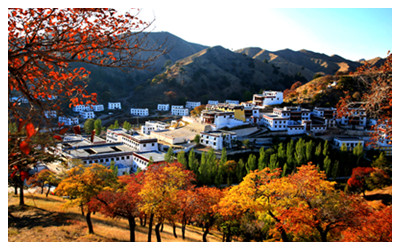Skype: neodalle-travel
Tel: +86 135 7447 2266
E-mail: sales@visitaroundchina.com
 Wudangzhao Monastery , situated in Wudanggou Valley on Daqing Mountain 54 kilometers north of Baotou City, is a large Tibetan Buddhist monastery. 'Bada Gele Monastery' is its Tibetan name, meaning white lotus. 'Wudangzhao' in Mongolian means 'willow'. Willows are prosperous in the valley, thus the name. Wudangzhao Monastery is the biggest and the best preserved lama monastery in Inner Mongolia's Autonomous Region, and it is a state-level key relics protection unit and a 4A-level scenic spot.
Wudangzhao Monastery , situated in Wudanggou Valley on Daqing Mountain 54 kilometers north of Baotou City, is a large Tibetan Buddhist monastery. 'Bada Gele Monastery' is its Tibetan name, meaning white lotus. 'Wudangzhao' in Mongolian means 'willow'. Willows are prosperous in the valley, thus the name. Wudangzhao Monastery is the biggest and the best preserved lama monastery in Inner Mongolia's Autonomous Region, and it is a state-level key relics protection unit and a 4A-level scenic spot.Suguqin Hall: Built in 1757, it is the biggest building in Wudangzhao, located in the forefront of the temple. The front hall is for chanting Buddhist scriptures. The Sakyamuni statue and 31 Bodhisattva statues are in the center. There are frescos depicting Sakyamuni's life story on both sides of the hall. Suguqin Hall is the gathering place of the temple.
Dongkuo'er Hall: Built in 1749, Dongkuo'er is a central building of Wudangzhao, as this was the place for the teaching of astronomy, geography, divinity, the calendar and mathematics. It was also named the "Auspicious and Mathematics School." Every March 15, an academic exam was held here. Both the examinees and examiner stood on the spacious platform in front of the hall. The examiner asked questions and the examinees answered and argued with each other.
Queyilin Hall: Built in 1835, it was second in scale only to Suguqin Hall. This was a place for special instruction in doctrine, and was therefore known as the "Religion Department" or "Philosophy School." The highest Sakyamuni Buddha bronze statue in Wudangzhao is in the hall. With a height of 10 meters, it is the biggest bronze Buddha statue in Inner Mongolia.
Ahui Hall: Built in 1800, this was the place for medical education. Therefore, it was called the "Medical Department" or "Medical School." Two wings --- "Esoteric Recipes" and "Medicine" --- were set up. The 18 arhat and the four deva-kings of the four quarters statue, steep and vivid clay sculpture cave, apothecary Buddha, Amitabha and White Tara are worshipped in the hall.
Rimulun Hall: Built in 1892, it was a Doctrine Department and the place to study the history of Lamaism and its doctrine and canons. A bronze statue of Tsongkhapa with a height of 9 meters is worshipped in the center of the hall and the statue is the biggest one of Tsongkhapa in Inner Mongolia. One-thousand small statues of Tsongkhapa are worshipped in the two areas upstairs and downstairs.
Travel Tips
Add: Jihulun Sumu, Shiguai district, Baotou, Inner Mongolia autonomous region.
Opening Hours: 08:00-17:00
Entrance Fees: CNY 60
 Ask Questions ?
Ask Questions ?